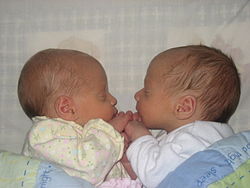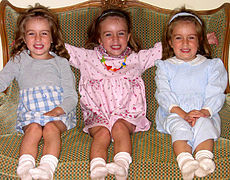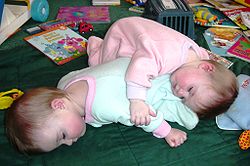- Multiple birth
-
A multiple birth occurs when more than one fetus is carried to term in a single pregnancy. Different names for multiple births are used, depending on the number of offspring. Common multiples are two and three, known as twins and triplets. These and other multiple births occur to varying degrees in most animal species, although the term is most applicable to placental species.
Multiple birth siblings are either monozygotic or dizygotic. The former result from a single fertilized egg or zygote splitting into two or more embryos, each carrying the same genetic material. Siblings created from one egg are commonly called identical. Since identical multiples share the same genetic material, they are almost always the same sex. Dizygotic or fraternal multiples instead result from multiple ova being ripened and released in the same menstrual cycle by a woman's ovaries, which are then fertilized to grow into multiples no more genetically alike than ordinary full siblings. Multiples called polyzygotic represent some combination of fraternal and identical siblings. For example, a set of triplets may be composed of identical twins from one egg and a third sibling from a second egg.
The most common form of multiple births for humans is twins. Many placental species give birth to multiples as a matter of course, with the resulting group called a litter.
Contents
Terminology
- Monozygotic – multiple (typically two) fetuses produced by the splitting of a single zygote
- Dizygotic – multiple (typically two) fetuses produced by two zygotes
- Polyzygotic – multiple fetuses produced by two or more zygotes
Terms used for the order of multiple births in human beings are largely derived from the Latin names for numbers. Two offspring (twins) is the most common form, eight (octuplets) is the largest number ever successfully carried to full term with all children surviving.
- Two offspring – twins
- Three offspring – triplets
- Four offspring – quadruplets
- Five offspring – quintuplets
- Six offspring – sextuplets
- Seven offspring – septuplets
- Eight offspring – octuplets
- Nine offspring – nonuplets
- Ten offspring – decaplets
- Eleven offspring – undecaplets
- Twelve offspring – duodecaplets
- Thirteen offspring – tridecaplets
- Fourteen offspring – quadecaplets
- Fifteen offspring – quindecaplets
- Sixteen offspring – sexdecuplets
- Seventeen offspring – sepdecuplets
- Eighteen offspring – octdecuplets
- Nineteen offspring – nondecuplets
- Twenty offspring – icosuplets
Higher order multiples
High orders of multiple births (three or more offspring in one birth) may result in a combination of fraternal (genetically different) and identical (genetically identical) siblings. The latter are also called super twins. For example, a set of quadruplets may consist of two sets of identical twins; in such a case each child has one identical and two fraternal siblings. This happens when multiple eggs are fertilized and one or more these subsequently divides into two fetuses. By analogy with monozygotic and dizygotic twins, such a combination is called dizygotic triplets. The Kübler triplets (see Elisabeth Kübler-Ross) were of this type.[1]
Identical triplets or quadruplets are very rare and result when the original fertilized egg splits and then one of the resultant cells splits again (for triplets) or, even more rarely, a further split occurs (for quadruplets). Alternatively the original fertilized egg can split twice (to produce four embryos) and all four may survive, to produce identical quadruplets, or one of the embryos may not survive and result in triplets.
Human multiple births
Twins are by far the most common multiples born live. Multiple births of as many as eight babies have been born alive, the first set on record to the Chukwu family in Texas in 1998; one died and seven survived. In 2009, a second set, the Suleman octuplets, was born in Bellflower, California. To date, all eight have survived.[2][3]
There have been a few sets of nonuplets (nine) in which a few babies were born alive, though none lived longer than a few days. There have been cases of human pregnancies that started out with ten, eleven, twelve or fifteen fetuses, but no instances of live births. The pregnancies of the 10, 11 and 15 fetuses have all resulted from fertility medications and assisted reproductive technology (ART). However there has been one documented case when 12 fetuses were conceived naturally.[4]
Multiple pregnancies in humans are usually born prior to 38 weeks of gestation[dubious ], the average length of pregnancy. Thirty-six weeks is average for twin births, thirty-two weeks for triplets and thirty weeks for quadruplets.
Quadruplets
Quadruplets result from the rare occurrence when four eggs are released and fertilized at once, or when one egg splits into four, or one egg splits into three with the fourth one fertilized, two eggs split into two, or one egg splits and two are fertilized. One famous set of quadruplets includes the Genain quadruplets who were identical quadruplets who all developed schizophrenia.
Causes and frequency
According to Hellin's Law, multiple births occur naturally at approximately the rate of:
- Twins: 1/89 (about 1.1%) of singleton births,
- Triplets: 1/892 = 1/7921 (about 0.013%) of singleton births, and
- N-tuplets: 1/89N-1 (app. 0.000142% for quadruplets, i.e. fewer than 1 quadruplet per 700,000 singleton births; even lower for higher N-tuplets)
North American dizygotic twinning occurs about once in 83 conceptions, and triplets about once in 8000 conceptions. In the US, there were over 136,000 multiple human births in 2003.[5] A traditional approximation of the incidence of multiple pregnancies is as follows:[6]
- Twins 1:80
- Triplets 1:80² = 1:6400
- N-tuplets 1:80N-1 [6]
 The Canadian Dionne sisters, seen in this 1947 photograph, were the first quintuplets known to survive infancy.
The Canadian Dionne sisters, seen in this 1947 photograph, were the first quintuplets known to survive infancy.
Human multiple births can occur either naturally (the woman ovulates multiple eggs or the fertilized egg splits into two) or as the result of infertility treatments such as IVF (several embryos are often transferred to compensate for lower quality) or fertility drugs (which can cause multiple eggs to mature in one ovulatory cycle).
For reasons that are not yet known, the older a woman is, the more likely she is to have a multiple birth naturally. It is theorized that this is due to the higher level of follicle-stimulating hormone that older women sometimes have as their ovaries respond more slowly to FSH stimulation.[7]
The number of multiple births has increased over the last decades. For example, in Canada between 1979 and 1999 the number of multiple birth babies increased 35%. Before the advent of ovulation-stimulating drugs, triplets were quite rare (approximately 1 in 8000 births) and higher order births much rarer still.[citation needed] Much of the increase can probably be attributed to the impact of fertility treatments, such as in-vitro fertilization. Younger patients who undergo treatment with fertility medication containing artificial FSH, followed by intrauterine insemination, are particularly at risk for multiple births of higher order.
 The Gosselin sextuplets with their parents and sisters, cover of KoreAm, May 2008
The Gosselin sextuplets with their parents and sisters, cover of KoreAm, May 2008
Certain factors appear to increase the likelihood that a woman will naturally conceive multiples. These include:
- mother's age — women over 35 are more likely to have multiples than younger women[citation needed]
- mother's use of fertility drugs — approximately 35% of pregnancies arising through the use of fertility treatments such as IVF involve more than one child
The increasing use of fertility drugs and consequent increased rate of multiple births has made the phenomenon of multiples increasingly visible in the public eye. In 2004, the birth of sextuplets to Pennsylvania couple Kate and Jon Gosselin helped them to launch their own highly popular television series, originally Jon & Kate Plus 8 and now (following their divorce) Kate Plus 8, which is the highest rated show on the TLC network.
Risks
Premature birth and low birth weight
Babies born from multiple-birth pregnancies are more likely to result in premature birth than those from single pregnancies. 51% of twins and 91% of triplets are born preterm, compared to 9.4% in singletons.[8] 14% of twins and 41% of triplets are even born very preterm, compared to 1.7% in singletons.[8]
The preterm births also result in multiples tending to have a lower birth weight compared to singletons.
Some evidence[who?] indicates that only 1.10% of singletons are born with a very low birth weight and 10.12% twins and 31.88% triplets were found to be born with very low birth weight. This Study[who?] was conducted by looking at the statistics from the U.S. Natality Files (5).
Among the exceptions are the Kupresak triplets of Mississauga, Ontario, Canada; their combined weight at birth in 2008, of 17 lbs, 2.7 ounces, set a world record.[9]
Cerebral palsy
Cerebral palsy is more common among multiple births than single births, being 2.3 per 1,000 survivors in singletons, 13 in twins, and 45 in triplets in North West England.[10]
Incomplete separation
Multiples may become monochorionic, sharing the same chorion, with resultant risk of twin-to-twin transfusion syndrome. Monochorionic multiples may even become monoamniotic, sharing the same amniotic sac, resulting in risk of umbilical cord compression and entanglement. In very rare cases, there may be conjoined twins, possibly impairing function of internal organs.
Mortality rate (stillbirth)
Multiples are also known to have a higher mortality rate. It is more common for multiple births to be stillborn, while for singletons the risk is not as high. A literary review on multiple pregnancies shows a study done on one set each of septuplets and octuplets, two sets of sextuplets, 8 sets of quintuplets, 17 sets of quadruplets, and 228 sets of triplets. By doing this study, Hammond found that the mean gestational age (how many weeks when birthed) at birth was 33.4 weeks for triplets and 31 weeks for quadruplets. This shows that stillbirth happens usually 3–5 weeks before the woman reaches full term and also that for sextuplets or higher it almost always ends in death of the fetuses.[11] Though multiples are at a greater risk of being stillborn, there is inconclusive evidence whether the actual mortality rate is higher in multiples than in singletons.
Fertility therapy problems and selective reduction
Today many multiple pregnancies are the result of fertility therapy. Elsner [12] studied 42 months of IVF (in vitro fertilization) procedures, and related the number of embryos transferred and the pregnancy outcome. In this time, they found that of the 2,173 embryo transfers performed, 734 were successfully delivered pregnancies (33.8%). These were analyzed…the overall multiple pregnancy rate was 31.3% (24.7% twins, 5.8% triplets, and .08% quadruplets). This evidence shows that almost all of the births delivered were multiples rather than singletons. Because IVFs are producing more multiples, a number of efforts are being made to reduce the risk of multiple births- specifically triplets or more. Medical practitioners are doing this by limiting the number of embryos per embryo transfer to one or two. That way, the risks for the mother and fetuses are decreased. De Sutter [13] found by looking at a previous study done in 1997, that by using SET (single embryo transfer) the twin birth rate dropped from 30% to 21%. Sutter also found that the use of this transfer method increased from 1.5% to 17.5%. So limiting the number of embryos transferred can reduce the risks of having multiples and so reduce the risks associated with multiple pregnancies.
Another procedure that the medical world is using today is known as selective reduction, i.e. the termination of one or more, but not all, of the fetuses. This is often done in pregnancies with multiple gestations to increase the likelihood that one child may live a healthy life. Armour [14] found by looking at a review of a series of 1,000 selective reduction cases, there has had a loss rate of 5.4% in pregnancies. Many of the losses (15%) occurred within 4 weeks of the procedures and more than 50% occurred after 8 weeks. This suggests that the reduction was successful at reducing the embryos from multiple gestations to single.
Though selective reduction seems to be working, mothers of multiples who undergo this procedure are at a higher risk of miscarrying compared to that of an unreduced multiple pregnancy. A study done by looking at 158 pregnant women who underwent selective reduction from higher order multiples to twins showed that the mother had a 10.6% chance of miscarriage. Mothers of twin pregnancies without reduction only had a 9.5% chance of miscarriage. Antsaklis [15] shows that there is a small increase in mortality for reduced twin pregnancies versus unreduced twin pregnancies.
Competition among fertility clinics does not appear to increase rates of multiple births from fertility treatment by promoting more aggressive embryo transfer decisions.[16]
Birthing process and neonatal intensive care
When it comes to the birthing process of multiples, mothers are more likely to receive a Caesarean (C-section) delivery than natural. Michael Kogan [17] found that between 1989–1991 and 1995-1997 the cesarean delivery rate for mothers of multiples increased from 21.9% to 27%. Kogan discovered this evidence by looking at the National Center for Health Statistics, births and infant death records for twins in the United States.
Multiple-birth infants are usually admitted to neonatal intensive care immediately after being born. The records for all the triplet pregnancies managed and delivered from 1992-1996 were looked over to see what the neonatal statistics were. Kaufman [18] found from reviewing these files that during a five year period, 55 triplet pregnancies, which is 165 babies, were delivered. Of the 165 babies 149 were admitted to neonatal intensive care after the delivery(90%).
Cultural aspects
Certain cultures consider multiple births a portent of either good or evil.[19]
Mayan culture saw twins as a blessing, and was fascinated by the idea of two bodies looking alike. The Mayans used to believe that twins were one soul that had fragmented.
In Ancient Rome, the legend of the twin brothers who founded the city (Romulus and Remus) made the birth of twin boys a blessing, while twin girls were seen as an unlucky burden, since both would have to be provided with an expensive dowry at about the same time.
In Greek mythology, fraternal twins Castor and Polydeuces, and Heracles and Iphicles, are sons of two different fathers. One of the twins (Polydeuces, Heracles) is the illegitimate son of the god Zeus; his brother is the son of their mother's mortal husband. A similar pair of twin sisters are Helen (of Troy) and Clytemnestra (who are also sisters of Castor and Polydeuces). The theme occurs in other mythologies as well, and is called superfecundation.
In certain medieval European chivalric romances, such as Marie de France's Le Fresne, a woman cites a multiple birth (often to a lower-class woman) as proof of adultery on her part; while this may reflect a widespread belief, it is invariably treated as malicious slander, to be justly punished by the accuser having a multiple birth of her own, and the events of the romance are triggered by her attempt to hide one or more of the children.[20] A similar effect occurs in the Knight of the Swan romance, in the Beatrix variants of the Swan-Children; her taunt is punished by giving birth to seven children at once, and her wicked mother-in-law returns her taunt before exposing the children.[21]
See also
- Only child
- Biological reproduction
- Conjoined twins
- List of multiple births
- List of twins
- Twin
- Feodor Vassilyev
- Half a Dozen Babies a 1999 drama film, about the 1993 born Dilley sextuplets.
- Superfecundation (multiple pregnancy resulting from separate sexual intercourses)
References
- ^ See Gill, Derek; Quest: The Life of Elisabeth Kübler Ross; p. 2 ISBN 0060115432
- ^ US woman gives birth to octuplets, BBC
- ^ Octuplets born in Bellflower, LA Times
- ^ Facts About Multiples
- ^ National Center for Health Statistics - Multiple Births
- ^ a b Melissa Bush, MD, & Martin L. Pernoll, MD (2006). Multiple Pregnancy. McGraw Hill Professional. http://books.google.com/books?id=9xD0inFiEIAC&pg=PA315&lpg=PA315&dq=%22melissa+bush%22+%2Bmultiple+pregnancy. Retrieved 2007-06-20.
- ^ Beemsterboer SN, Homburg R, Gorter NA, Schats R, Hompes PG, Lambalk CB. The paradox of declining fertility but increasing twinning rates with advancing maternal age. Hum Reprod. 2006 Jun;21(6):1531-2. Epub 2006 Feb 23. PubMed PMID:16497698.
- ^ a b Alexander G., Kogan M., Martin J., and Papiernik E. (1998). What are the fetal growth patterns of singletons, twins, and triplets in the United States? Clinical Obstetrics and Gynecology, 41(1), 114-125. Note: This study was done by looking at the 1991-1995 U.S. Natality Files, which were received from the National Center for Health Statistics
- ^ Le, Julia (26 July 2011). "Scale-tipping triplets set world record". Mississauga News (Mississauga ON). http://www.mississauga.com/community/community/article/1048642. Retrieved 26 July 2011.; note that the record wasn't confirmed until July 2011.
- ^ Pharoah PO., and Cooke T. (1996). Cerebral palsy and multiple births [abstract]. Archives of Disease in Childhood-Fetal and Neonatal Edition, 75, 174-177. Note: They conducted a study by looking at the registered births of babies born with cerebral palsy during the periods of 1982-1989 in the counties of Merseyside and Cheshire.
- ^ Hammond K. (1989). Multifetal pregnancy reduction. Journal of Obstetrics and Gynecological and Neonatal Nursing, 27(3), 338-343
- ^ Elsner C., Tucker M., Sweitzer C., Brockman W., Morton P., Wright G., and Toledo A. (1997). Multiple pregnancy rate and embryo number transferred during in vitro fertilization. American Journal of Obstetrics and Gynecology, 177(2), 350-355
- ^ De Sutter P., Van der Elst J., Coetsier T., and Dhont M. (2003). Single embryo transfer and multiple pregnancy rate reduction in IVF/ICIS: a 5 year appraisal. Reproductive BioMedicine Online 6(4), 464-469
- ^ Armour K., and Callister L. (2005). Prevention of triplets and high order multiples: Trends in reproductive medicine. Journal of Perinatal and Neonatal Nursing, 19, 103-111
- ^ Antsaklis A., Drakakis P., Vlazakis G., and Michalas S. (1998). Reduction of multifetal pregnancies to twins does not increase obstetrics or perinatal risks. Human Reproduction, 14(5) 1338-1340
- ^ Henne MB, Bundorf MK (April 2010). "The effects of competition on assisted reproductive technology outcomes". Fertil. Steril. 93 (6): 1820–30. doi:10.1016/j.fertnstert.2008.02.159. PMID 18442821.
- ^ Kogan M., Alexander G., Kotelchuck M., Macdorman M., Buckens P., Martin J., and Papiernik E. (2000). Trends in twin birth outcomes and prenatal care utilization in the United States, 1981-1997. The Journal of American Medical Association, 284(3), 335-341
- ^ Kaufamn GE., Malone FD., Harvey-Wilkes KB., Chelmow D., Penzias AD., and D’ Alton ME. (1998). Neonatal morbidity and mortality associated with triplet pregnancy. Obstetrics and Gynecologists, 91, 342-348
- ^ "Korea's 'lucky' triplets seized". Herald Sun (Fairfax). 2003-03-30.
- ^ Laura A. Hibbard, Medieval Romance in England p295, 244 New York Burt Franklin,1963
- ^ Laura A. Hibbard, Medieval Romance in England p239, 243 New York Burt Franklin,1963
External links
- Facts About Multiples
- HFEA consultation on multiple births after IVF
- D. L. Ashliman, Multiple Births in Legend and Folklore
Pregnancy and childbirth Planning Conception Testing Prenatal AnatomyProceduresChildbirth PreparationRolesDeliveryPelvimetry/Bishop score: Cervical dilation · Cervical effacement · Position
Home birth · Multiple birth · Natural childbirth · Unassisted childbirth · Water birth
Bloody show · Childbirth positions · Contraction · Presentation (Breech, Cephalic, Shoulder) · Rupture of membranesPostpartum Obstetric history Categories:- Reproduction
- Multiple births
- Zoology
Wikimedia Foundation. 2010.




